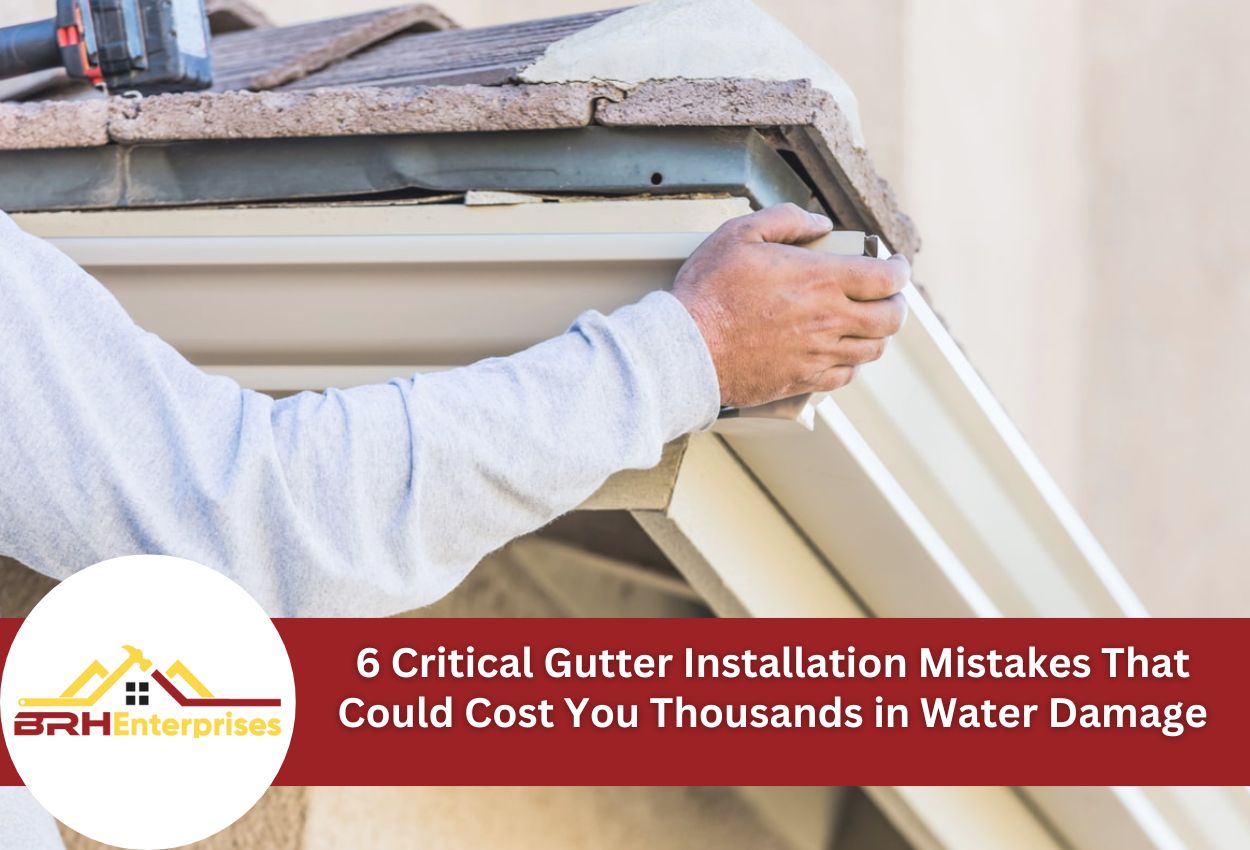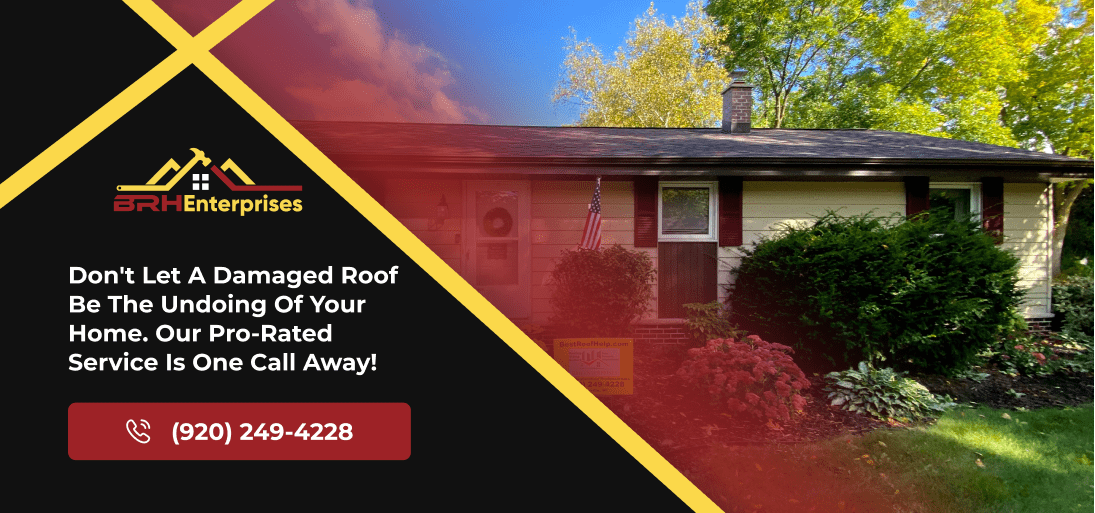6 Critical Gutter Installation Mistakes That Could Cost You Thousands in Water Damage
Estimated Reading Time : 6 Min.

Gutters are one of the most crucial elements that protect your home from water damage. When gutters fail due to improper installation, the consequences extend far beyond simple leaks. Water can cascade down exterior walls, pool around foundations, and destroy carefully maintained landscaping. These issues often develop gradually, making them difficult to detect until significant damage has already occurred.
Common gutter installation errors plague both do-it-yourself homeowners and inexperienced contractors. Improper gutter slope ranks among the most frequent mistakes, causing water to pool rather than flow toward downspouts. Gutter hanging mistakes create weak points that fail under the weight of water and debris, while downspout placement issues direct water toward foundations or walkways instead of safely away from structures.
Gutter sizing problems can compound these installation challenges. Undersized gutters overflow during heavy rainfall, while oversized systems create unnecessary expense and aesthetic concerns. Each of these gutter installation mistakes to avoid can transform this protective system into a source of major property damage.
Understanding these critical errors before installation begins protects homeowners from expensive repairs and ensures gutters function effectively for decades. Recognizing these common pitfalls allows property owners to make informed decisions about their gutter installation.
#1. How Insufficient Slope Can Turn Your Gutters Into Pools
Achieving proper gutter slope is one of the most critical aspects of effective water management. The recommended pitch is a gentle decline of at least 1/4 inch for every 10 feet of gutter length toward the nearest downspout. This slope ensures consistent water flow while maintaining an aesthetically pleasing appearance along the roofline.
Even minor deviations from this standard slope can create significant drainage problems. When gutters lack sufficient pitch, water accumulates in low spots and refuses to flow toward downspouts. This stagnant water becomes a breeding ground for mosquitoes and other pests, promotes the growth of algae, and allows debris to build up. Over time, standing water adds excessive weight that strains gutter hangers and can cause system failure.
Creating slope during installation requires a quality level, measuring tape, and a string line for accuracy. Professional installers mark the highest point at the gutter run and calculate the total drop needed based on the distance to the downspout. Common gutter installation errors occur when installers eyeball the slope or fail to account for existing roofline irregularities.
Improper gutter slope problems often result in water spilling over the gutter edges during moderate rainfall, potentially damaging the home exterior. This overflow defeats the entire purpose of the gutter system and directs water toward areas where it can cause foundation damage or erosion issues around the property.
#2. Improper Hanger Spacing and Attachment Methods that Lead to Sagging Gutters
Correct hanger spacing forms the backbone of any reliable gutter system, yet remains one of the most overlooked aspects during installation. Standard spacing requirements vary between different gutter materials and styles, with some gutters requiring hangers every 24 inches and heavier materials needing support every 18 inches. In areas prone to consistent snowfall in winter, reducing this spacing to 16 inches provides additional structural integrity that prevents system failure during harsh weather conditions.
Inadequate support creates a domino effect of problems that compound over time. Gutters begin pulling away from fascia boards as hangers fail under accumulated weight from water, leaves, and seasonal debris. This separation allows water to flow behind the gutter system, potentially damaging underlying roof structures and exterior walls. Sagging sections develop between improperly spaced hangers, creating low points where water pools instead of flowing toward downspouts.
Selecting appropriate fasteners depends entirely on roof construction and fascia board composition. Standard gutter screws work effectively for traditional wood fascia, while metal fascia necessitates specialized fasteners designed for that specific material.
These hanging mistakes are common gutter installation errors that transform functional drainage systems into sources of water damage. Proper attachment techniques ensure gutters remain securely positioned throughout their expected lifespan while effectively channeling water away from vulnerable building components.
#3. Downspout Placement Errors That Create Drainage Nightmares
Downspout positioning determines whether water flows safely away from your property or creates expensive damage around foundations and walkways. Proper placement requires considering natural drainage patterns, existing landscaping, and the distance needed to direct water to appropriate disposal areas. Each downspout must handle a specific section of roof area, with standard calculations allowing one downspout per 20 to 35 feet of gutter run or 600 square feet of roof surface.
The most damaging downspout placement issues occur when contractors position outlets too close to building foundations. Water discharged within 6 feet of foundation walls can seep into basement areas, create hydrostatic pressure against foundation walls, and cause settlement problems that affect structural integrity. Similarly, directing water onto driveways or walkways creates icy hazards during winter and accelerates concrete deterioration as puddles freeze and thaw.
Inadequate drainage capacity often becomes apparent during heavy rainfall when improperly spaced downspouts cannot handle the volume of water flowing from gutters. This overflow typically occurs at gutter corners and creates the same foundation risks that proper downspout placement should eliminate. Common gutter installation errors include relying on too few downspouts or positioning them for convenience rather than optimal water management.
Effective drainage planning extends beyond downspout location to include extension installation and grading that carries water away from structures. These considerations prevent the gutter installation mistakes that transform these protective systems into sources of property damage.
#4. Why Choosing the Wrong Gutter Size Creates Overflow Problems
Determining appropriate gutter dimensions requires looking at multiple factors that influence expected water volume during rainfall. Roof area measurements provide the foundation for these calculations, but local rainfall data transforms basic square footage into realistic capacity requirements. Standard 5-inch gutters handle most residential applications effectively, while 6-inch systems become necessary for larger roof areas or regions with frequent heavy precipitation.
Calculating gutter capacity begins with measuring the roof’s effective drainage area, which includes not only the horizontal surface but also accounts for roof pitch and wind-driven rain. Steep rooflines collect and direct more water into gutters compared to shallow slopes, requiring larger capacity systems to prevent overflow during storms. Architectural features like dormers, valleys, and multiple roof planes concentrate water flow into specific gutter sections that may need oversized components.
Gutter width and downspout diameter work together to create a balanced system that prevents bottlenecks during peak water flow periods. Standard 5-inch gutters paired with inadequate 3-inch downspouts create overflow conditions regardless of the gutter size chosen. Conversely, oversized downspouts cannot compensate for undersized gutters that lack sufficient collection capacity during intense rainfall.
Gutter sizing problems are expensive installation errors that compromise entire drainage systems. When gutters overflow consistently, water cascades over the edges and defeats the protection these systems should provide. Understanding these capacity relationships prevents the overflow issues that damage foundations, landscaping, and building exteriors throughout the system’s life.
#5. Sealing and Joint Connection Failures That Cause Leaks
Sealing at gutter connections is the final line of defense against water infiltration that can damage building structures and compromise system performance. Corner joints, end caps, and seam connections require specific sealing materials and application methods that create lasting watertight barriers. Professional-grade sealants outperform standard household caulks in exterior applications, providing flexibility that accommodates thermal expansion and contraction cycles without cracking or separating.
Surface preparation determines whether sealing succeeds or fails within the first season after installation. Clean, dry surfaces free from dirt, old sealant residue, and oxidation allow new materials to bond effectively with gutter components. Many installers rush through this preparation phase, applying sealants over contaminated surfaces that prevent proper adhesion. This shortcut creates the appearance of proper sealing while likely ending premature failure.
Temperature and weather conditions during sealant application also impact long-term performance. Applying sealants in temperatures below 40 degrees Fahrenheit or during high humidity compromises the curing process and reduces bond strength. These common gutter installation errors often occur when contractors attempt to complete projects during unfavorable weather rather than scheduling work for better conditions.
Connection failure patterns typically develop at stress points where thermal movement concentrates on sealed joints. Recognizing these vulnerable areas during installation allows contractors to apply reinforcement techniques that extend seal life and maintain water-tight performance in seasonal weather changes that challenge gutter system integrity.
#6. Poor Planning and Measurement Mistakes That Waste Time and Money
Thorough pre-installation planning prevents the majority of expensive mistakes that plague gutter installations. Accurate measurements are necessary for successful projects, yet many contractors rush through this critical phase and create cascading problems that multiply costs and installation time. Precise roof measurements, fascia board assessments, and material calculations ensure enough supplies arrive on-site while avoiding wasteful over-ordering or project delays from material shortages.
A site assessment can reveal potential challenges before installation begins, allowing contractors to develop solutions rather than improvise during active work. Roof irregularities, architectural features like bay windows or dormers, and existing damage to fascia boards require specific approaches that differ from standard installation procedures. Identifying these conditions during the planning stage prevents common gutter installation errors that occur when contractors encounter unexpected situations without proper preparation.
Installation plans should account for local building code requirements, permit needs, and seasonal weather patterns that affect project scheduling. Many jurisdictions require specific attachment methods, gutter sizing standards, or downspout discharge regulations that impact your material options and the installation techniques used. Knowing these requirements beforehand prevents rework and ensures the installation meets all local regulations.
Additionally, planning ahead helps reduce material waste, which protects budgets and demonstrates a professional’s competence with gutter work. Proper calculations account for corner pieces, downspout components, and fastener quantities needed for complete installation. These planning steps eliminate gutter installation mistakes that transform projects into expensive learning experiences for both contractors and homeowners.
Avoid Gutter Installation Errors with BRH Enterprises LLC
When it comes to gutter installation, the margin for error is slim. Mistakes not only lead to immediate water damage but can also cause long-term structural issues that are expensive to fix. At BRH Enterprises LLC, we understand the critical nature of precise gutter installation. Whether it’s ensuring the right slope for optimal water flow, selecting the appropriate gutter size, or placing downspouts strategically, our team follows a meticulous approach that avoids common pitfalls.
Call us today at (920) 249-4228 to schedule a consultation and ensure your gutter system is installed correctly and efficiently. Trust BRH Enterprises LLC to protect your home from preventable water damage by avoiding common gutter installation errors.


